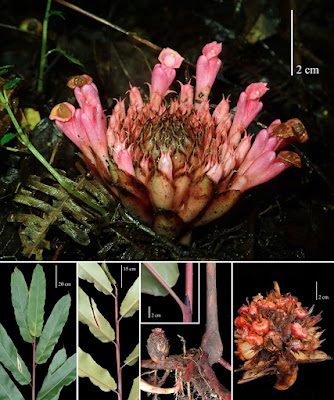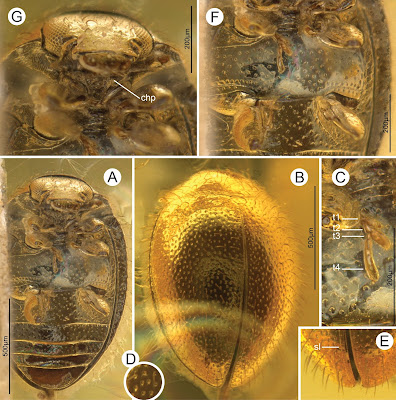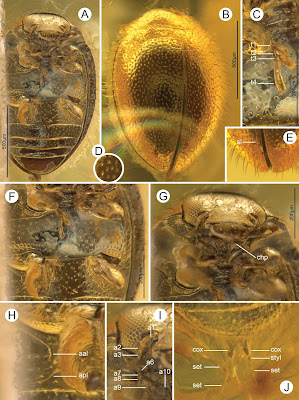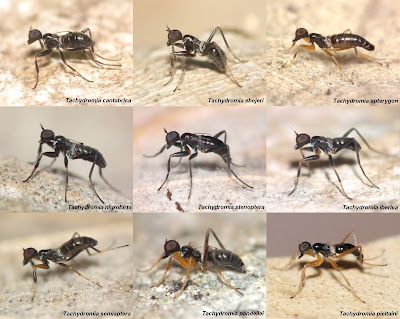[Most Recent Entries] [Calendar View]
Tuesday, February 16th, 2021
| Time | Event | ||
| 2:18a | [Botany • 2020] Etlingera tjiasmantoi (Zingiberaceae) • A New Species from Central Sulawesi, Indonesia
Abstract A new species of Etlingera, Etlingera tjiasmantoi Ardiyani & Ardi, was discovered at Tentena, Central Sulawesi, and is described here. This species resembles Etlingera flexuosa A.D.Poulsen and Etlingera mamasarum A.D.Poulsen & Ardiyani but differs from both in having thecae dehiscing through their entire length and in the obovoid, glabrous and spineless fruits. The DNA barcode data, the line drawings of flower and fruit and the plate of E. tjiasmantoi were presented. Keywords: DNA barcode, Etlingera flexuosa, E. mamasarum, Indonesia, Zingiberales. Etlingera tjiasmantoi Ardiyani & Ardi spec. nov. Etlingera tjiasmantoi is similar to E. flexuosaA.D.Poulsen and E. mamasarum A.D.Poulsen & Ardiyani in having entire ligules with ± emarginate apex, long petioles (around 4 cm), elongated elliptic to narrowly ovate laminas, pointed calyces, and ± pink flowers but E. tjiasmantoi differs from both in having thecae dehiscing through their entire length (vs. in upper part) and in the obovoid, glabrous and spineless fruits (vs. pyriform or round, pubescent and with small spines). Habitat & Ecology. Grows in secondary forest by the road between Tentena and Bada, near a waterfall and a stream at about 1,700 m asl. Etymology. The epithet honours Mr. Wewin Tjiasmanto who funded the botanical trip to Central Sulawesi, and who is greatly concerned for wildlife, taxonomy, exploration and conservation. Marlina Ardiyani, Wisnu Handoyo Ardi, Wahyudi Santoso and Axel Dalberg Poulsen. 2020. Etlingera tjiasmantoi (Zingiberaceae), A New Species from Central Sulawesi. Reinwardtia. 19(2); ; 103‒108. DOI: 10.14203/reinwardtia.v19i2.3972 Congratulations to Dr. Marlina Ardiyani @MarlinaArdiyani and Wisnu Ardi @Begonia_Wisnu who in March this year, discovered a new species of Etlingera in Central Sulawesi. Today, E. tjiasmantoi is published in REINWARDTIA bringing the number of Etlingera species in Sulawesi to 48. | ||
| 8:58a | [PaleoEntomology • 2021] Baltosidis gen. nov. • The First Fossil Microweiseini (Coleoptera: Coccinellidae) from the Eocene of Europe and Its Significance for the Reconstruction of the Evolution of Ladybird Beetles Abstract Molecular studies on the evolution of ladybird beetles date their origin somewhere in the Cretaceous, but no fossils are known from that period. The oldest representatives come from the Eocene, with the richest diversity found in Baltic amber. Until now, representatives of only three tribes (from around 40 known) have been recognized. Recent investigation of Baltic amber have revealed representatives of the fourth tribe (Microweiseini), which are described here as Baltosidis gen. nov. with three new species: B. damgaardi sp. nov., B. damzeni sp. nov. and B. szadziewskii sp. nov. In order to test the systematic placement of this extinct genus, a phylogenetic analysis of Microweiseinae was conducted. The results place Baltosidis in a cluster with four modern genera of Microweiseini distributed exclusively in the New World. Such a distribution pattern is surprising because no close relatives of the newly described fossil genus are known from Europe or even from the Palaearctic region. Analysis of the distribution of Microweiseini genera leads to the conclusion of a possible Gondwanan origin of the tribe. Further comparison of the diversity of the ladybird beetles from modern ecosystems with those known from Baltic amber suggests substantial differences between these communities and a recent radiation of modern fauna. Keywords: Baltic amber, biogeography, Coccinelloidea, Eocene, evolution, new genus, palaeontology Systematic palaeontology Order Coleoptera Linnaeus, 1758 Suborder Polyphaga Emery, 1886 Superfamily Coccinelloidea Latreille, 1807 Family Coccinellidae Latreille, 1807 Subfamily Microweiseinae Leng, 1920 Tribe Microweiseini Leng, 1920 Genus †Baltosidis gen. nov. Type species: †Baltosidis damzeni. Diagnosis: Baltosidis is most similar to the genus Parasidis, having ten antennomere antenna with three-antennomere club, ventrite 1 with complete or almost complete v-shape abdominal postcoxal lines and four tarsomeres. However, it can be distinguished by a presence of distinct sutural carinae placed in the apical half of elytra. From similar-looking Coccidophilus Brèthes, 1905 and Stictospilus Brèthes, 1924, it can be separated by four-segmented tarsi (three segmented in both genera) and an antennal club consisting of three antennomeres (in Coccidophilus it consists of two antennomeres). Etymology: First part of the name is derived from the Baltic Sea, the second refers to the genus Parasidis to which it is related. Baltosidis damgaardi sp. nov. Diagnosis: Baltosidis damgaardi can be distinguished from congeners by pronotum and elytra covered with two types of setae: long, stiff bristles intermixed with short hairs. Moreover, its abdominal postcoxal lines are widely separated from accessory lines. Ventral surface setose. Etymology: The specific epithet is dedicated to Anders L. Damgaard (Copenhagen, Denmark), collector of one of the paratypes, who allowed me to examine his collection of coccinellid beetles. Locality and horizon: Eocene, Baltic amber, Gulf of Gdańsk area (secondary deposit). Baltosidis damzeni sp. nov. Diagnosis: Baltosidis damzeni can be distinguished from other Baltosidis species by glabrous pronotum and elytra, abdominal postcoxal lines almost fused with accessory lines, but not forming distinctly closed v-shape. Ventral surface glabrous. Etymology: The specific epithet is dedicated to my friend Jonas Damzen (Vilnius, Lithuania) collector and donator of the type specimens to the MAIG. Locality and horizon: Eocene, Baltic amber, Gulf of Gdańsk area (secondary deposit). Baltosidis szadziewskii sp. nov. Diagnosis: Baltosidis szadziewskii is characterized by fine, short setae on pronotum and elytra, abdominal postcoxal lines fused with accessory lines apically forming v-shape. Ventral surface setose. Etymology: The specific epithet is dedicated to Prof. Ryszard Szadziewski (University of Gdańsk, Poland), entomologist and expert on recent and fossil Ceratopogonidae (Diptera), who encouraged me to investigate Baltic amber coleopterans. Locality and horizon: Eocene, Baltic amber, Gulf of Gdańsk area (secondary deposit). Karol Szawaryn. 2021. The First Fossil Microweiseini (Coleoptera: Coccinellidae) from the Eocene of Europe and Its Significance for the Reconstruction of the Evolution of Ladybird Beetles. Zoological Journal of the Linnean Society. zlaa180. DOI: 10.1093/zoolinnean/zlaa180 | ||
| 9:32a | [Entomology • 2021] Revision of the Morphology, Phylogenetic Relationships, Behaviour and Diversity of the Iberian and Italian Ant-like Tachydromia Meigen, 1803 (Diptera: Hybotidae) ABSTRACT Phylogenetic inference, based on five molecular markers (COI, 28S, AATS, 12S, PGD), corroborates the synonymy of the flightless genera Pieltainia Arias, 1919 and Ariasella Gil, 1923 with Tachydromia Meigen, 1803. The secondary structure of the 28S rRNA gene is used for the first time in this family to align the multiple sequences. Molecular and morphological data are largely congruent for all known species of flightless Tachydromia. This paper treats ten western Mediterranean species (nine Iberian and one Italian) in detail, including the description of four new species: T. ebejeri Gonçalves, Grootaert & Andrade sp. nov., T. stenoptera Gonçalves, Grootaert & Andrade sp. nov., T. cantabrica Gonçalves, Grootaert & Andrade sp. nov. and T. nigrohirta Gonçalves, Grootaert & Andrade sp. nov. The male of Tachydromia pieltaini (Gil Collado, 1936) and the female of Tachydromia apterygon Plant & Deeming, 2006 are described for the first time, while a lectotype is assigned to Tachydromia pandellei (Séguy, 1941). A key to all non-macropterous Tachydromia is supplied. Knowledge on the geographic distribution of most species is considerably enhanced. The mating behaviour of Tachydromia semiaptera (Gil Collado, 1923) and Tachydromia iberica (Arias, 1919) is documented for the first time, and we propose a change in the definition of terms apterous and micropterous to properly accommodate the diversity of wing states in this cluster of species. Keywords: Iberian Peninsula, Hybotidae, flightless, molecular phylogeny, synonym, new species Phylum Arthropoda Latreille, 1829 Class Insecta Linnaeus, 1758 Order Diptera Linnaeus, 1758 Infraorder Muscomorpha Sharp, 1894 Superfamily Empidoidea Latreille, 1804 Family Hybotidae Meigen, 1820 Subfamily Tachydromiinae Meigen, 1822 Genus Tachydromia Meigen, 1803 Tachydromia apterygon Plant & Deeming, 2006 Tachydromia iberica (Arias, 1919) Tachydromia lusitanica (Grootaert, Shamshev & Andrade, 2009) Tachydromia pandellei (Séguy, 1941) Tachydromia pieltaini (Gil Collado, 1936) Tachydromia semiaptera (Gil Collado, 1923) Tachydromia cantabrica Gonçalves, Grootaert & Andrade sp. nov. Diagnosis: Overall dark. Wing dimorphic: male stenopterous; wing with lobed distal apex, no veins distinguishable, dark brown for most part, with black and white lobe; female micropterous, wing bilobate, with 1 seta on each lobe. Palpi, proboscis and antennae black; postpedicel sub-conical, ca1.5 times as long as pedicel. Legs with a colour pattern of yellowish and dark brown to black; male fore tibia with ciliation of long hairlike setae. Abdomen black, tergites and sternites with evenly distributed setae, covered with grey microtrichia. It shares similarities with T. nigrohirta sp. nov. and T. stenoptera sp. nov., but can be distinguished from these species by the darker leg colouration, lobed distal apex of male wing without any trace of apical digitation, sub-conical postpedicel, and male terminalia. Etymology: This species is named after the Spanish Cantabrian mountain range, where it was found. Distribution: Spain. Currently only known from the Cantabrian Mountains. Tachydromia ebejeri Gonçalves, Grootaert & Andrade sp. nov. Diagnosis: Overall dark. Micropterous, with minute squamiform wings in both sexes. Palpi, proboscis and antennae black; postpedicel lanceolate, ca1.5 times longer than pedicel. Legs with a colour pattern of yellowish and dark brown to black; fore tibia with ciliation of long hair-like setae. Abdomen black, covered with grey microtrichia and with distinct, strong, setae on posterior margin of first sternite. It shares general similarities with T. cantabrica sp. nov., T. stenoptera sp. nov. T. nigrohirta sp. nov. and T. lusitanica, from which it can be mainly distinguished by microptery in both sexes - while the males of the other species are stenopterous - and male terminalia. Etymology: The species is named after the dipterologist Martin J. Ebejer for his contribution to the advancement of the knowledge on Portuguese Diptera. Distribution: Portugal and Spain. Mostly distributed in the northwestern Iberia (North and Central Portugal and Galicia), with just one locality south of the Tagus river (Santa Maria de Marvão). Tachydromia nigrohirta Gonçalves, Grootaert & Andrade sp. nov. Diagnosis: Overall very dark and hirsute. Wing dimorphic: male stenopterous; lobed distal apex, suboval, with minute digitation on apical margin. Stalk-like process dark brown on basal half, pale on distal half; distal ⅔ of lobe black, basal ⅓ and digitation translucid; female micropterous, wing bilobate. Palpi, proboscis and antennae black. Postpedicel lanceolate, 2 times as long as pedicel; stylus 1.5 times as long as scape, pedicel and postpedicel combined. Legs mostly black except for yellowish to pale brown trochanters, knees and tarsomeres 1 and 2. Abdomen black, tergites uniformly covered by grey microtrichia and long setae. It closely resembles T. lusitanica, from which it can mainly be distinguished by the noticeably darker leg colouration, male wing with only a minute digitation on apical margin, and male terminalia. Etymology: Name composed of two Latin words: ‘niger’(nigro) meaning ‘black’ and ‘hīrtus’ (hirta) meaning ‘hairy’. The name combination indicates that this is a characteristically dark and hairy species. Tachydromia stenoptera Gonçalves, Grootaert & Andrade sp. nov. Diagnosis: Overall very dark. Wing dimorphic: male stenopterous; wing with slightly lobed distal apex, dark for most part and lobe black and white; female micropterous, wing bilobate. Palpi, proboscis and antennae black; postpedicel lanceolate, ca1.5 times as long as pedicel. Legs almost completely black. Abdomen black, tergites mostly glabrous and without grey microtrichia. Etymology: The name of this species means ‘narrow wing’ and derives from the combination of two Greek words: the prefix steno- (stenos), meaning ‘narrow’, with the suffix -ptera (pterá), meaning ‘wing’. Hence, the name reflects the very narrow lobed distal apex of the male wing. Ana Rita Gonçalves, Patrick Grootaert, Rui Andrade, Octávio S. Paulo and Ximo Mengual. 2021. Revision of the Morphology, Phylogenetic Relationships, Behaviour and Diversity of the Iberian and Italian Ant-like Tachydromia Meigen, 1803 (Diptera: Hybotidae). European Journal of Taxonomy. 732(1), 1-56. DOI 10.5852/ejt.2021.732.1213 |
| << Previous Day |
2021/02/16 [Calendar] |
Next Day >> |


















